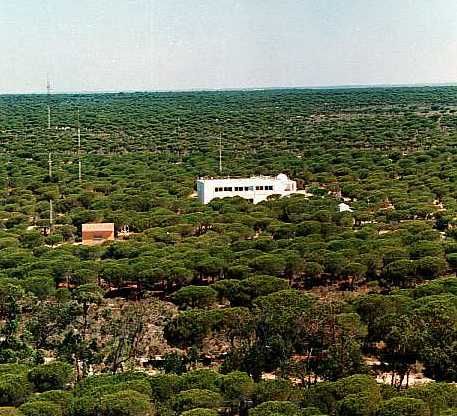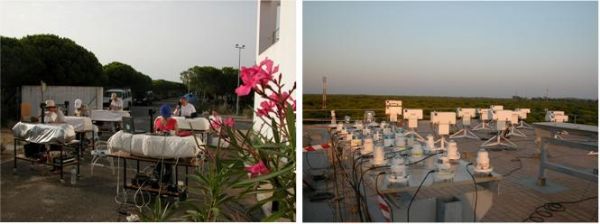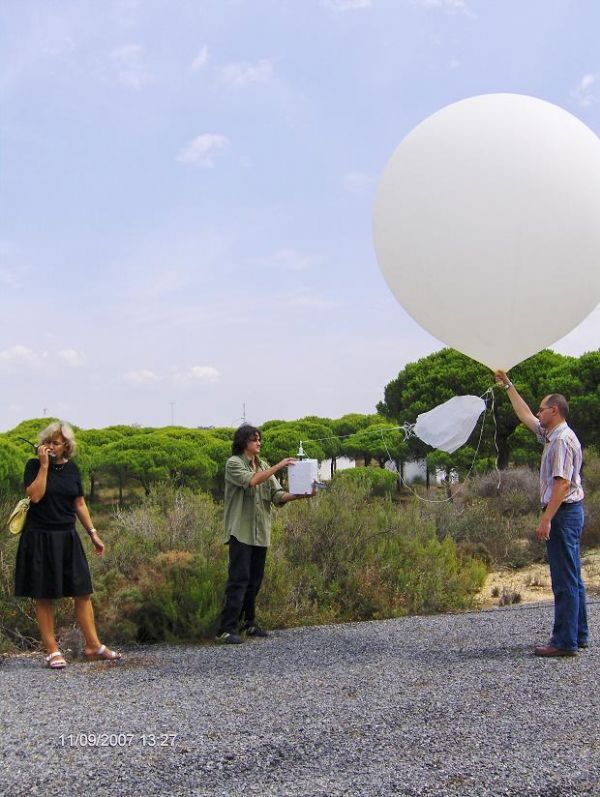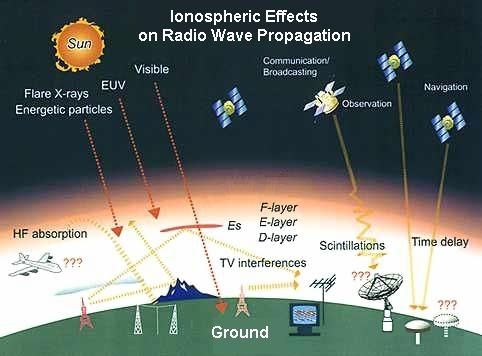Atmospheric Survey Station - ESAt (37ºN, 7ºW)

ESAt Description
The Atmospheric Sounding Station is located in the coastal area surrounding Doñana National park, near the village of Mazagón (Huelva), in a rural area far from pollutant sources. With more than 300 clear sky days a year, it offers an excellent location for atmospheric observation. International intercomparisons are carried out in order to guaranty the quality control of networks of spectrophotometers measuring ozone and UV radiation, Broadband radiometers and aerosol photometers.
Its activity is mainly experimental and it is structured around the following lines:
- - Stratospheric ozone and solar radiation.
- - Aerosols.
- - Atmospheric pollution and meteorology.
- - Ionosphere.
Head: Dra. Margarita Yela González
Contact: Dr. Jose Antonio Adame Carnero adamecj@inta.es

Stratospheric Ozone and Solar Radiation
Ozone and solar ultraviolet radiation activities represent one of the main research lines of the ESAt since 1980. There are available ozone data since 1980, being the longest ozone time series in Spain. There are also available more than ten years of UV spectral irradiance and erythemal irradiance records.
Within these research lines, the following can be pointed out:
- Total ozone content measurements with the Dobson#120 spectrophotometer since 1980.
- Continuous monitoring and application of standard QA/QC criteria to the database and instruments:
- Erythemal irradiance by using a YES UVB-1 biometer since 1996.
- Brewer MK-III#150 since 1997, measuring total ozone content, spectral UV irradiance, SO2 and AOD in the UV region.
- Eldonet radiometer since 1998, measuring 3 broadband channel in UV.B, UV.A and PAR solar irradiance respectively.
- YES MFR-7 multi filter rotating shadow band, since 2001 measuring global, direct and diffuse ultraviolet radiation in 7 channels.
- Kipp Zonen CM11 piranometer, since 2007, measuring global solar radiation.
- All sky camera, since 2007, measures the sky state.
The different studies carried out comprise a great deal of atmospheric parameters necessary for the knowledge and study of the ozone and ultraviolet radiation climatology, and the processes which affect it, the impact of ultraviolet radiation on the environment and influence of cloudiness on the ultraviolet radiation, and total ozone content among others.
The ESAt is the station 213 of the Ozone World Watch Network and has a Radiometric Calibration Laboratory in which numerous instruments measuring solar radiation are calibrated and possible sources of error which can influence the data are studied.
Due to the excellent geographical location, horizon, climatology and infrastructures; the ESAt is the head office for national and international calibration campaigns for instruments measuring ozone and solar radiation. This observatory, also due to the excellent relations with many research institutions, is frequently used to host instruments from other centers.
Nowadays, the ESAT collaborates very actively with several national and international institutions among which the following can be pointed out: the “Consejería de Medio Ambiente de la Junta de Andalucía”, University of Extremadura, “Agencia Estatal española de meteorología” (AEMET), the World Radiation Center (PMOD/WRC), COST-726 European Action, etc.
Contacto: vilaplanagjm@inta.es

Atmospheric Aerosols
Study of the atmospheric aerosol. Determination of their properties in relation with climate and quality air. Sun Photometer field and laboratory calibration.
- Efectos climáticos globales y regionales del aerosol en superficie y en columna
- - Sub- and super- micrometric particle size distribution (SMPS and APS particle spectrometer, Ultrafine Particle Counter).
- - Light scattering properties of atmospheric aerosols (3-wavelength integrating nephelometer). The nephelometer is operated in-flight with the Particle Soot Absorption Photometer (PSAP). Calculation of the aerosol single scattering albedo is possible.
- -Aerosol mass concentration (PM1, PM2.5 and PM10 by Dekati and MCVs samplers) and Chemical analysis (ionic chromatography, atomic absorption, etc) to know Sulphates (SO4 -2 ) contribution, Nitrates (NO3 - ), Ammonium (NH4 + ), Cl- ,Na+ , Al, Si and Ca++ .
- - Aerosol refraction index and absorption coefficients.
- - Solar polarized sun-photometer (Cimel, model CE318) determinates direct solar and sky radiance measurements, which allow to evaluate aerosol optical depth, Angström alpha coefficient, SSA, refractive index, asymmetry parameter and effective volume particle size distribution. This instrument operates within of the AERONET network (AErosol RObot NETwork).
- Study of the aerosol climatology in Gulf of Cádiz. Aerosol type classification using spectral and radiative properties. Assignment of sources nearby by chemical measurements and by air mass back trajectory analysis. Inventory of African desert dust events over southwestern Iberian Peninsula by means of photometric detection.
Contact: Mar Sorribas Panero, sorribasm@inta.es

Atmospheric Pollution and Meteorology
Characterisation and behaviour of several air pollutants such as surface ozone, nitrogen oxides, carbon monoxide and volatile organic compounds. As well as are studied different meteorological aspects in order to improve the understanding of the atmospheric dynamic in the south of Spain.
Observations/Research
- -Identification of main routes of transportation of air pollutants by meteorological studies.
- - Meso-scale processes in coastal areas.
- - Synoptic classification air masses.
- - Temporal evolution of surface meteorological parameters at given scenarios.
- - Lower atmosphere vertical structure by using sounding meteorological profiles at El Arenosillo.
- - Collaboration with the Ansalusian Government since 2004 for Air Quality Network analyses. In particular to determinate the transport pathways of air pollutants in the south of Iberian Peninsula and classify the monitoring stations according to the levels recorded and different meteorological scenarios.
- - Local climatology study and Urban Heat Island in the Seville metropolitan area.
Contact: José Antonio Adame Carnero, adamecj@inta.es

Ionosphere
- - Maintenance of the Ionosonde DGS-256 and installation of new versions of software applications for data treatment. Calculation of electronic density profiles.
- - Systematic delivery of ionospheric data to the World Data Centers USA (WDC A), Russia (WDC B), Japan (WDC C2), UK (WDC C1), European Centers and Universities.
- - Collaboration in the DIAS European Project for the construction of a European net of ionospheric maps and models.
- - Operation of a Double Frequency GPS receiver for measuring the Total Electron Content (TEC) over a mediterranean net of GPS receivers for the three-dimensional characterization of the ionospheric TEC (MIRTO project).
- - Participation in European actions COST: COST 238 (Prediction and Retrospective Ionospheric Modelling over Europe) (1991-1995), COST 254 (Improved Quality of Service in Ionospheric Telecommunication Systems Planning and Operation) (1996-1999), COST 271 (Effects of the Upper Atmosphere on Terrestrial and Earth-Space Communications) (2000-2004), COST 296 (Mitigation of Ionospheric Effects on Radio Systems) (2005-2009).
- - panish-Argentine collaboration for the investigation of the influence of ionospherics anomaly in satellite communications, financed by AECI (International Collaboration Spanish Agency).
Contact: José Antonio Adame Carnero, adamecj@inta.es
Website DGS-256: http://iono.inta.es
